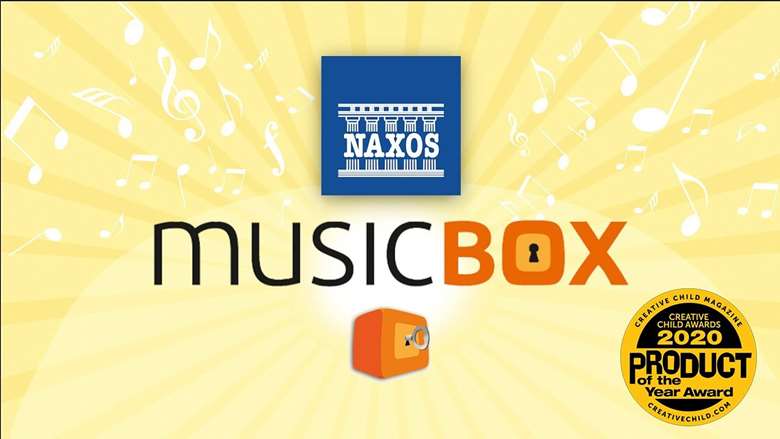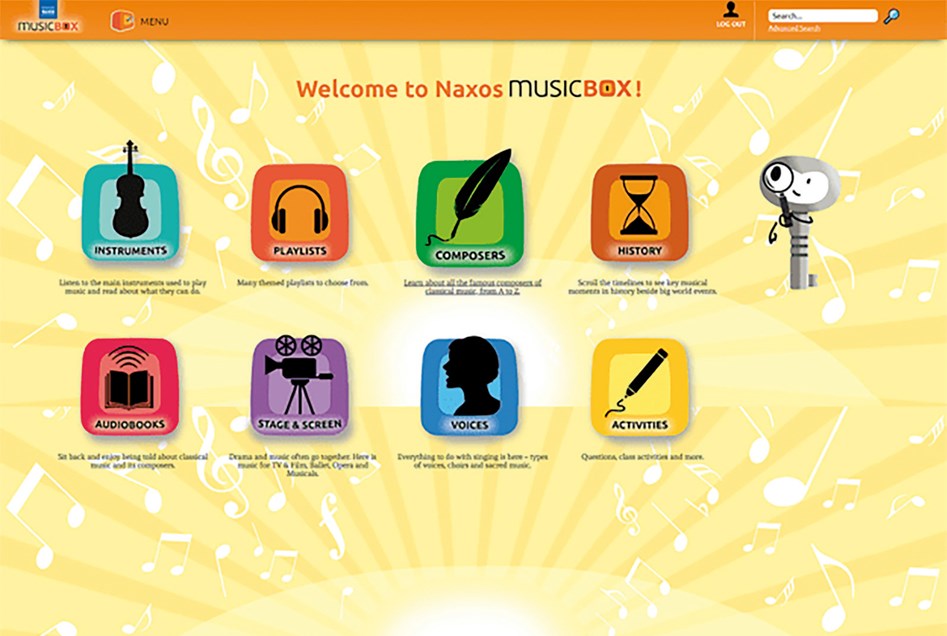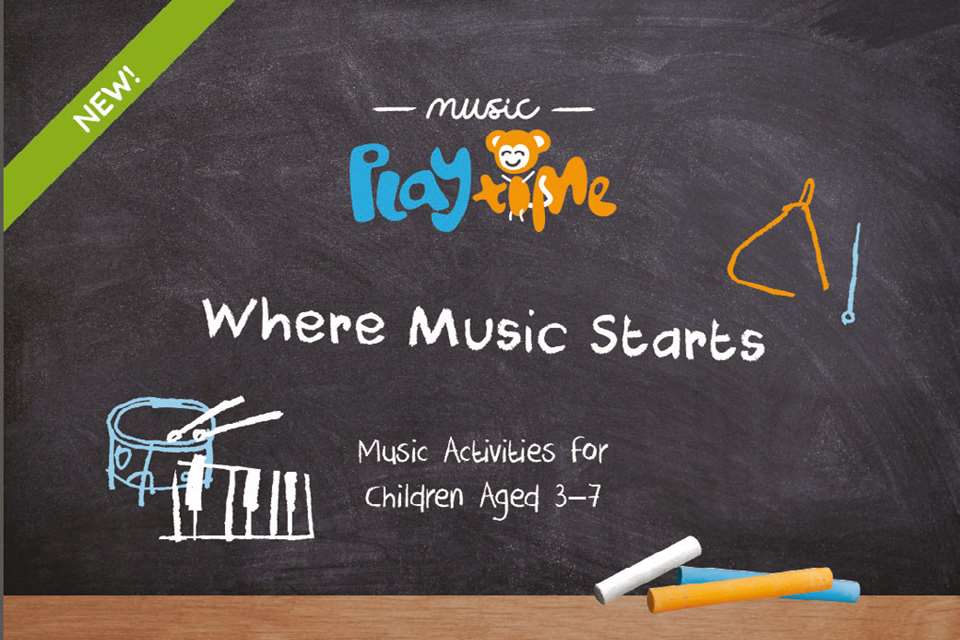Tech Reviews: Naxos MusicBox
David Guinane
Monday, February 1, 2021
David Guinane reviews Naxos MusicBox.

There are countless online resources claiming to be a one-stop shop for all things classical music. For any educator, specialist, or non-specialist, this can be overwhelming when planning and delivering a music curriculum. Naxos, an undisputed big-hitter in the world of classical music recordings, has recently released MusicBox – an award-winning music resource for 4- to 12-year-olds.
Naxos has long enjoyed an excellent reputation for bringing classical music to huge audiences, chiefly through its extensive catalogue of attractively priced record releases. Its championing of new music, lesser known works from around the world, and up-and-coming musicians has earnt them a global reputation.
What is it?
The Naxos MusicBox project is a collection of articles, playlists, resources, and activities designed to introduce young children to ‘the wonderful world of music’. Launched in 2020, it is available through yearly subscriptions, and advertises itself to classroom teachers, as well as parents wishing to enrich their children's musical education at home.
When looking at these sorts of sites, prospective subscribers should consider content, layout, ease of use (for students and staff), as well as how involved students are when using the site. Are they just listening and reading? Or are they answering questions, interrogating the information, and thinking musically? We should also consider how ‘we’, as the teacher – who best understands our own students and contexts – would use the information. Is it an additional resource for the most able? Is it a source of tasks to complete at home, or something we intend to integrate fully into our music curricula on a regular basis?

The layout is bright, colourful, and easy to navigate
Does it deliver?
The Naxos MusicBox is colourful, clear, and well presented. Nothing is difficult to find or more than a few clicks away. I found out about how an oboe works just as easily as I discovered the compositional processes of Arvo Pärt. The material presented is not new; it is the same core knowledge of the Western Classical canon that we have become accustomed to. There are playlists, arranged by composer, period, or theme (I enjoyed the themes, as creative music curation can be really engaging to new listeners), and there is no shortage of high-quality listening examples and articles.
Naxos MusicBox is at its best when dealing with musical extracts and encyclopaedia-style articles. A few of the features, such as the timeline, feel less developed. For example, many of the facts – and their links to classical music history – are not given sufficient context, and there is no way to click to find out more. It will be interesting to see how the forthcoming feature, ‘Music Around the World’, will complement what is already there. The addition of audiobooks, with a choice of narrator, selectable chapters, and integration of musical examples, is a really nice feature. But, at the time of writing, only three books are featured, all by Darren Henley and featuring the voices of Marin Alsop and Aled Jones.
Who is it for?
Naxos say their MusicBox site is aimed at young people from 4–12. I think the scope of this resource extends beyond 12-year-olds. The information on composers featured is comprehensive, and the well-chosen playlists would be useful for any student studying music at a higher level. As I've mentioned, the listening questions are demanding, and many would challenge my KS3 students. The audiobooks are well-known titles that have an adult readership, and I don't feel that the user interface is too juvenile to put off older students – it is well designed with a broad appeal.
As a general rule, the guidance suggests that the practical activities and songs are tailored for a younger age group (4–6), whereas the resources and playlists are intended for older students (6–12). I think they have drawn a suitable distinction, though I would have liked to have seen more of a differentiated approach to sections such as Instruments, which are focused on the youngest, and Listening activities, which cater for older students.
Perhaps a beginner and advanced approach to both listening and learning about instruments would be more valuable across the board. In addition, more practical tasks for older students, such as classroom arrangements or compositional projects in response to certain pieces, would be welcome.
Though I cannot authentically speak on behalf of non-specialist music teachers, I do consider this resource to be sufficiently detailed to allow any educator (including parents) to guide students through the material. Perhaps in future, Naxos MusicBox could add schemes of learning that cover multiple weeks, allowing non-specialists to design an appropriate, longer-term journey through the site. There is a lot to choose from, it is all high quality, and as such some pathways would be helpful.
What's new?
Though much of this information is available for free elsewhere in the vast expanse of the internet, the curation and authenticity of the material is what you pay for here. This is where the reputation of the Naxos brand pays dividends, as they can draw on their expertise and extensive back catalogue. Particularly for KS1 and 2, a well-organised selection of resources can be hugely helpful for time-poor practitioners striving for a broad curriculum. In this sense, Naxos MusicBox is well worth your consideration.
The drawbacks
My reservations about the product are less about the design and content of the site, and more about the choices made when it comes to presenting the Western Musical canon. There are only two female composers featured: Clara Schumann and Hildegard of Bingen. There are three living composers profiled, and all of them are white, male, and very old. An alternative approach to engaging young people with ‘classical music’ would focus on a more diverse set of composers, as well as those currently working and creating within this broad tradition.
However, if Naxos MusicBox is designed solely to teach students about a particular set of composers, instruments, and musical forms, it does an excellent job; the resources are appropriate, and the pedagogy is sound.
Stepping back, I worry that this kind of approach is too narrow. So much thinking around teaching ‘Classical’ music rightly focusses on ensuring young people see themselves represented in the art forms they study. In a world where projects such as BBC Ten Pieces expose us to working composers from a range of backgrounds, the representation of diverse cultures in Naxos MusicBox could be improved.
How much does it cost?
Prices start from £2 per user per year, with big discounts when more seats are purchased. It is important to note that the product is new, and that it is continually updated. If this future material is as high in quality as what is currently available, it can only grow in value as a resource. A free trial of the education version is available through Julian Edwards at Naxos, and I would encourage you to have a look around.
For information visit naxosmusicbox.com or email Julian at jedwards@naxosmusic.co.uk


